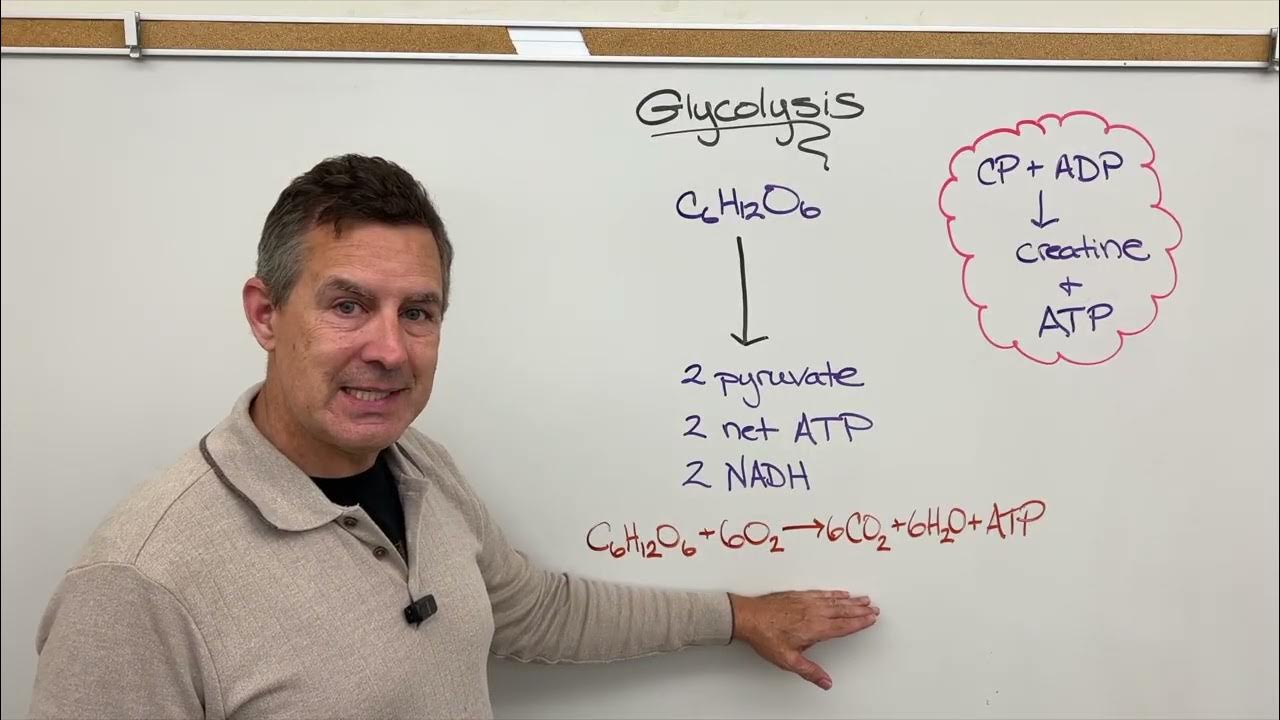Dissimilatie - de oxidatieve fosforylering - VWO
Summary
TLDRThis video explains the process of oxidative phosphorylation, a crucial part of cellular respiration that takes place in the mitochondria. It explores how electrons from NADH and FADH2 are transported through the electron transport chain, generating a proton gradient across the inner mitochondrial membrane. This gradient powers ATP synthesis via ATP synthase. The process also highlights the role of oxygen as the final electron acceptor, forming water. The video provides a detailed breakdown of the steps, key molecules involved, and how glucose metabolism ultimately results in the production of ATP, the cell's energy currency.
Takeaways
- 😀 Oxidative phosphorylation is a crucial process in cellular respiration, following glycolysis and the citric acid cycle.
- 😀 The process begins with the breakdown of glucose, releasing CO2 and H2O, and producing a small amount of ATP.
- 😀 NADH and FADH2 are generated during earlier stages (glycolysis, citric acid cycle) and carry electrons for the electron transport chain (ETC).
- 😀 The mitochondrion is essential for oxidative phosphorylation, with two membranes: an outer and a highly folded inner membrane.
- 😀 The electron transport chain (ETC) consists of four protein complexes that transport electrons across the inner mitochondrial membrane.
- 😀 Electrons are passed from one protein complex to the next, while protons (H+) are pumped into the intermembrane space, creating a concentration gradient.
- 😀 ATP synthase (complex 5) uses the proton gradient to synthesize ATP as protons flow back into the mitochondrial matrix.
- 😀 The energy from electron flow is used to pump protons against their gradient, contributing to the formation of a proton gradient.
- 😀 Oxygen acts as the final electron acceptor in the ETC, combining with electrons and protons to form water, allowing the electron chain to continue.
- 😀 In ideal conditions, one NADH can generate 3 ATP, and one FADH2 can generate 2 ATP, with a theoretical total of 38 ATP from one glucose molecule.
Q & A
What is oxidative phosphorylation?
-Oxidative phosphorylation is the final stage of cellular respiration where energy stored in molecules like NADH and FADH2 is used to produce ATP in the mitochondria, involving the electron transport chain and ATP synthase.
What are the main molecules involved in oxidative phosphorylation?
-The main molecules involved are NADH, FADH2, oxygen, and ATP. NADH and FADH2 donate electrons to the electron transport chain, while oxygen acts as the final electron acceptor, and ATP is produced by ATP synthase.
How is ATP produced during oxidative phosphorylation?
-ATP is produced when protons (H+) flow back into the mitochondrial matrix through ATP synthase, which uses this flow of protons to generate ATP from ADP and inorganic phosphate.
What role does oxygen play in oxidative phosphorylation?
-Oxygen serves as the final electron acceptor in the electron transport chain. It combines with electrons and protons to form water, enabling the continuous flow of electrons through the chain.
What are the protein complexes involved in the electron transport chain?
-The electron transport chain consists of four protein complexes (Complex I-IV) embedded in the inner mitochondrial membrane. These complexes transport electrons and pump protons across the membrane.
What is the purpose of pumping protons across the mitochondrial membrane?
-Pumping protons across the mitochondrial membrane into the intermembrane space creates a proton gradient, which is crucial for generating ATP through the flow of protons back into the matrix via ATP synthase.
How many ATP molecules are theoretically produced from one glucose molecule during oxidative phosphorylation?
-The theoretical yield is 38 ATP molecules per glucose: 2 from glycolysis, 2 from the citric acid cycle, and 34 from oxidative phosphorylation, under ideal conditions.
What happens if oxygen is not available for oxidative phosphorylation?
-Without oxygen, the electron transport chain cannot function properly because electrons would not be accepted at the end of the chain, halting the entire process and preventing ATP production.
Why is the inner mitochondrial membrane highly folded?
-The inner mitochondrial membrane is highly folded (forming cristae) to increase surface area, allowing more proteins and enzymes involved in oxidative phosphorylation to be embedded, which enhances the efficiency of ATP production.
What is the actual ATP yield from oxidative phosphorylation in practice?
-In practice, the ATP yield is slightly lower than the theoretical maximum of 38 ATP, due to inefficiencies in the system. Typically, around 30 ATP molecules are produced per glucose molecule.
Outlines

This section is available to paid users only. Please upgrade to access this part.
Upgrade NowMindmap

This section is available to paid users only. Please upgrade to access this part.
Upgrade NowKeywords

This section is available to paid users only. Please upgrade to access this part.
Upgrade NowHighlights

This section is available to paid users only. Please upgrade to access this part.
Upgrade NowTranscripts

This section is available to paid users only. Please upgrade to access this part.
Upgrade NowBrowse More Related Video
5.0 / 5 (0 votes)





